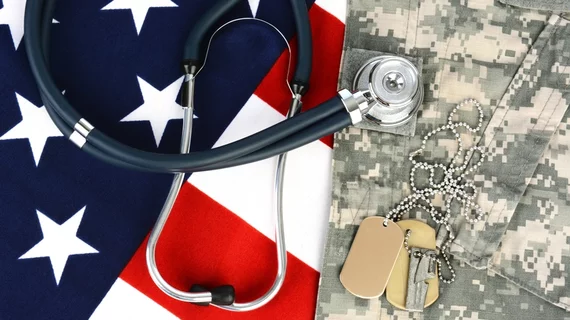United States veterans receiving invasive coronary procedures have become older and sicker over the past several years, according to a study published online May 2 in JACC: Cardiovascular Interventions. The good news? Mortality rates associated with percutaneous coronary intervention (PCI) have remained steady despite the increasing patient complexity.
Stephen W. Waldo, MD, with the VA Eastern Colorado Healthcare System in Denver, and colleagues studied all coronary angiographies and PCIs performed at Veterans Affairs (VA) facilities from 2009 through 2015. This included nearly 200,000 angiographies and about 85,000 PCIs. Evaluating trends from the first year of the study to the last, they found:
- The Framingham risk score—a measure to calculate the 10-year risk of coronary heart disease events—increased from 20 to 25 percent for patients undergoing angiography and from 24 to 32 percent for those receiving PCI. This reflects the advancing age and increasing comorbidity burden of the population.
- The number of interventions performed each year remained steady, as did post-PCI medical prescriptions. Throughout the study period, about 73 percent of patients received all four classes of studied medications following the intervention: antiplatelets, angiotensin antagonists, beta-blockers and statins.
- Transradial access increased over time from 5 to 32 percent for diagnostic procedures and from 6 to 36 percent for interventional procedures.
- There was a nonsignificant trend toward lower mortality for those undergoing PCI after risk adjustment (adjusted hazard ratio: 0.983).
“Taken together, the data suggest that the increasing medical complexity with time has not led to worsening of clinical outcomes for patients in the VA healthcare system,” Waldo and colleagues wrote. “Furthermore, the complication rates observed in the largest integrated healthcare system in the United States compare very favorably with the voluntary reporting in similar community-based programs. These data highlight the potential benefits of an integrated healthcare system using a heart team approach as well as a central organization to monitor the overall quality and safety of invasive cardiac procedures.”
The increased use of the radial approach, according to the authors, was evidence of improved care over time. They noted the 36 percent of transradial PCIs observed at the end of this study exceeded the 26 percent recently reported from nonfederal hospitals but remained “well behind practice patterns in Europe, suggesting a potential opportunity for improvement.”
In an accompanying editorial, two cardiologists from Duke University pointed out it might not be fair to evaluate complication rates between nonfederal and federal facilities given that many VA systems don’t have 24-hour cath labs and therefore treat fewer patients with ST-segment elevation myocardial infarction. That said, the superior uptake of the radial approach found in VA hospitals was notable, the editorialists said.
“The explanation for the more rapid rise of transradial catheterization may be rooted in the educational advantages of an integrated health system and quicker cultural acceptance of this approach by VA interventionalists, a process non-federal facilities should strive for,” wrote Jennifer A. Rymer, MD, and Manesh R. Patel, MD.
Rymer and Patel also pointed out the prescription rates post-PCI were superior in this VA study compared to previous reports of community hospitals.
“Because cost to the patient and patient access to medications are major factors in prescribing habits, the VA health system has a clear advantage over non-federal hospitals,” they wrote. “All VA prescriptions typically cost less than $8 out of pocket to the patient, and the patient is generally prescribed a 90-day prescription at discharge.
“Although a recent analysis demonstrated that 90-day prescriptions after an MI improve 12-month medication adherence, the majority of non-VA post-MI patients are prescribed 30-day prescriptions. These differences in medication costs and prescribing practices in the VA system are likely critical for improved outcomes and better medication adherence in an older population with greater comorbidities.”
The Duke researchers called for real-time PCI risk assessment tools that account for this increasingly complex patient population and inform procedural decisions and post-operative medical management. In addition, they said calculations to determine how quickly people can be discharged from the hospital may need refinement given these population changes.

